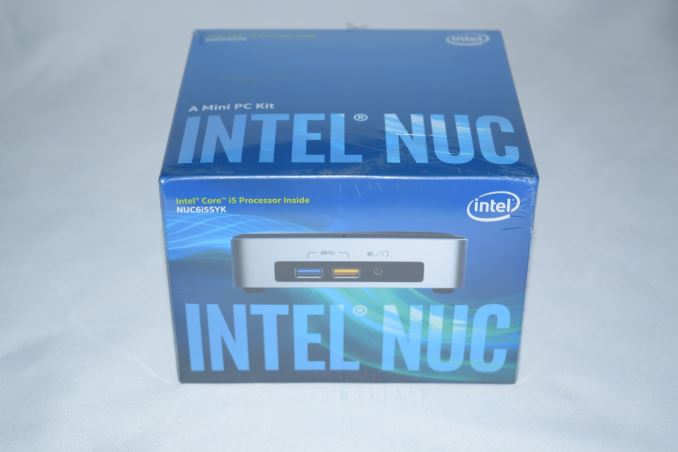Intel Releases BIOS Version 0044 for Skylake NUCs
by Ganesh T S on May 17, 2016 4:30 PM EST
BIOS updates for motherboards and mini-PCs aren't usually important enough to warrant explicit coverage. However, Intel's latest release for the Skylake NUCs (the Core i3 and Core i5 versions - NUC6i3SYK, NUC6i3SYH, NUC6i5SYK and NUC6i5SYH) deserves special mention for a number of fixes that have been made.
Intel's launch of the Skylake NUCs was quite muted, with review units making it to the press a few months after market availability. In the meanwhile, consumers were beset with problems ranging from memory incompatibility issues and Wi-Fi flakiness to unexplained BSODs. We encountered a bunch of these in our own review, and went to the extent of recommending the unit only if the reader wanted to be a beta-tester for Intel.
Fortunately, Intel has been hard at work to get to the bottom of all the reported problems. The last two BIOS releases (0042 and 004) have solved a number of serious issues, including, but not restricted to:
- Improved electrical overstress protection in the voltage regulator circuitry - this was the reason for BSODs with WHEA_UNCORRECTABLE_ERROR reports.
- Changed default value for Round Trip Latency to Enabled - this was the reason for incompatibility with some memory modules fabricated by SKHynix.
- Improved BIOS update function to disable keyboard and power button during flash/recovery process - this could have helped me in avoiding the bricking of our first review sample of the NUC6i5SYK.
- Fixed issue where Wi-Fi access point occasionally drops out during warm boot - this solves the strange case of the missing 5GHz SSID upon restarting the NUC
- Changed FITC setting, OPI Link Speed to GT4 - this is the performance fix for PCIe 3.0 x4 NVMe SSDs
If you are facing issues with a Skylake NUC, updating to BIOS v0044 should resolve almost all of the problems. Readers curious about the OPI link speed and its effect on the performance and power consumption characteristics of a Skylake-U system can peruse our detailed coverage posted last week.
Note that the OPI link rate changes can only be realized using the Recovery BIOS update method (using the jumpers). Intel indicated that the new BIOS installs and functions without doing the Recovery BIOS update, but it will not make the changes needed for the OPI link rate fix. The required changes are not in the portions of the BIOS that are replaced during a normal BIOS update. After the update, it is also necessary to set BIOS system defaults by pressing the F9 function key
Source: Intel










30 Comments
View All Comments
MrCommunistGen - Tuesday, May 17, 2016 - link
Sweet! Glad to see this update be released as well as a publicized update to the state of the union on the Skylake NUCs.Ganesh, any chance you might attach a link to this Pipeline post in the original NUC review to at least partially amend the relatively bad rap the Skylake NUC got in the initial review?
If I were in the market for a NUC this'd be great news overall for the platform. As is, my next SFF machine will need to do 4K60.
ganeshts - Tuesday, May 17, 2016 - link
Done! Update posted at the end of the original review: http://www.anandtech.com/show/10121/intel-nuc6i5sy...MrCommunistGen - Tuesday, May 17, 2016 - link
Thanks!I feel that in a lot of cases, updates significantly past the release date of a product (for better or for worse) often get lost in the shuffle and can result in a lot of uncertainty to the casual reader who doesn't follow the issues closely.
Dreamwalker - Wednesday, May 18, 2016 - link
Its 2016, not 2015;)"Update (May 17, 2015): "
cygnus1 - Tuesday, May 17, 2016 - link
I read on one of the Intel forum threads that if you're getting these BSOD's, you're hardware is basically already toast and to send it in to Intel. That sucks that a firmware voltage setting problem was able to kill good hardware.
hojnikb - Tuesday, May 17, 2016 - link
even chinese x86 boxes dont have that many bugs.pretty sad of intel
Flunk - Tuesday, May 17, 2016 - link
Sure they do, they just don't fix them.hojnikb - Wednesday, May 18, 2016 - link
Believe it or not, they do. I have a noname z3735f box and as far as i'm aware it gor atleast two bios updates.ikjadoon - Tuesday, May 17, 2016 - link
What's up with "top of the food chain" companies like Intel and Microsoft releasing iffy hardware? First the Surface Book had BSODs and sleep issues, then Intel had BSODs and RAM incompatibility.Aren't these *just* the companies who you would think could get BSODs out of the way on launch day?
I don't get how BSODs are still a thing in 2016 on new hardware. Feel like I've been transported back to the early 2000s with Vista.
cm2187 - Wednesday, May 18, 2016 - link
You are giving a lot of credit to these companies. I heard the head of the Windows division had already been fired by the time he walked up on stage to introduce Windows 8. Microsoft knew it was a piece of shit, the OEM warned them repeatdly but they went ahead with the launch anyway. It is very common with large organisations where no one really owns anything (and at the end of the day really gives a shit), are moving extremely slowly, and where it is very common for senior management to get intoxicated with the fume of their own bullshit!